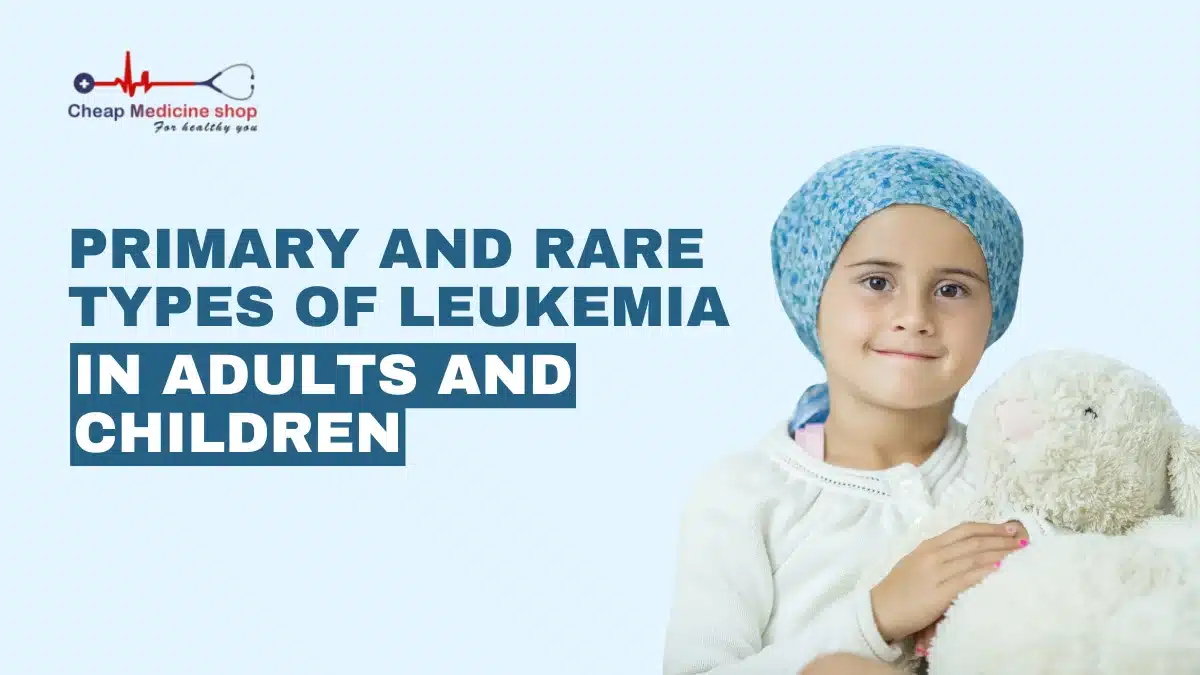Leukemia occurs when Cancer develops in the blood cells within the bone marrow. It can grow fast or slow and can start in two main cell lines. You may feel tired, bleed easily, or get infections often.
There are several different types of Leukemia. Doctors group them based on two main things. First, they look at how quickly the disease gets worse. Second, they look at the type of white blood cell affected. Knowing these details helps doctors plan the most appropriate care for an individual.
When you or someone you care about faces a Leukemia diagnosis, questions flood in fast. You want to know precisely what the 4 types of Leukemia are, what makes each unique, and how to find the best care.
This article breaks down each major form, Acute Leukemia types and chronic Leukemia types, and also explores less common forms such as ball-type Leukemia and Leukemia linked to viruses.
Types of Leukemia
People often want to know, ‘What are the 4 types of Leukemia?’ To answer the question, these four main groups combine speed and cell line:
1. Acute Lymphocytic Leukemia (ALL)
2. Acute Myelogenous Leukemia (AML)
3. Chronic Lymphocytic Leukemia (CLL)
4. Chronic Myelogenous Leukemia (CML)
However, not all Leukemias fit the 4 main types. There are also some other rare types. Below are all the different key types of Leukemia.
Save up to 90% on your medicine bills

Abraxane 100 Mg Injection

Alphalan 5 Mg Tablets

Adriamycin 50 Mg Injection

Abirapro 250 Mg Tablet
Acute Lymphoblastic Leukemia (ALL)
Acute Lymphocytic Leukemia (also referred as Acute Lymphoblastic Leukemia) is a fast-growing Cancer of immature lymphocytes. This type of Leukemia is more common in children, but it can also occur in adults. You may notice fatigue, fever, bone pain, or easy bruising.
Among pediatric Leukemia types, ALL has high cure rates with modern therapy in kids. Treatment often uses multi‐medication chemotherapy and sometimes targeted antibodies. Adults may need higher‐dose treatments. Side effects can be more severe.
Begin chemotherapy promptly to attack rapidly dividing cells, and if remission doesn’t stay, proceed with a bone marrow transplant. Recent trials in the Haematologica Journal (2024) show that adding targeted antibodies can improve remission rates in high-risk cases.
Acute Myelogenous (Myeloid) Leukemia (AML)
AML (Acute Myeloid Leukemia) is another name for Acute Myelogenous Leukemia. Other names include Acute Myelocytic Leukemia and Acute Granulocytic Leukemia. They refer to the same disease, a blood and bone marrow Cancer characterized by the rapid growth of abnormal myeloid cells.
It progresses rapidly in adults. There are many subtypessub-types of Acute Myelogenous Leukemia, such as Acute Promyelocytic Leukemia (APL), classified based on cell differentiation, genetic abnormalities, and clinical features. Each subtype guides specific treatment plans.
You might have infections, weight loss, or bleeding. Standard chemotherapy induces remission in about 50%–80% of people under 60, but relapse is common.
AML has a notably lower 5-year relative survival rate, around 31.7% to 31.9%, making it often labeled the worst type of Leukemia. Newer agents (e.g., FLT3 inhibitors) offer hope, and clinical trial participation can give you cutting-edge options.
Chronic Lymphocytic Leukemia of B-Cell Type (CLL)
Chronic Lymphocytic Leukemia of B-cell type grows slowly in lymphoid cells. CLL is a chronic Leukemia type that affects B-lymphocytes in adults over 55. It is most common in adults over 60 years.
It often shows no symptoms early, but you may later feel swollen lymph nodes or fatigue. Some individuals feel well or normal for years, so doctors often watch and wait before starting treatment.
You can watch and wait initially, delaying treatment until needed, because early therapy doesn’t improve survival. When treatment is required, oral targeted medications (BTK inhibitors) are generally better tolerated than older chemo regimens.
When compared to other medications, Ibrutinib works faster, but Venetoclax may give longer remissions. The two medications target different CLL cell populations and mechanisms.
Combination therapy of Ibrutinib and Venetoclax shows promising results with higher complete response rates and prolonged remissions. Each has different side effects, so talk with your doctor to see which fits you.
Chronic Myeloid (Myelogenous) Leukemia (CML)
CML is a slower-growing type of Myeloid Leukemia, often detected by routine blood tests. You may have an enlarged spleen, feel tired, or have night sweats. It is linked to the BCR-ABL gene, also called the Philadelphia chromosome.
First‐line medications like Imatinib (FDA-approved 2001) and Dasatinib (FDA-approved 2006) block the bad gene. Imatinib is proven effective and well-tolerated, but acts more slowly. Dasatinib works faster but can cause fluid buildup. Both are effective; your doctor can help you choose based on your health and goals.
Furthermore, the discovery of Gleevec (Imatinib) revolutionized care, turning CML into a manageable condition with daily pills. Long-term follow-up shows over 90% 5-year survival when individuals stay on therapy.
Hairy Cell Leukemia (HCL)
Hairy Cell Leukemia is a slow, chronic Leukemia with ‘hairy’ cells on lab tests. HCL is one of the rare Leukemia types and mainly affects middle-aged men. You may experience severe fatigue and infections due to low blood counts.
Treated with targeted chemotherapy, it often responds well. Treatment with purine analogs achieves long remissions in most people, and newer monoclonal antibodies help those who relapse.
Human T-cell Leukemia Virus Type 1 (HTLV-1) or Adult T-cell Leukemia/Lymphoma (ATLL)
Human T-cell Leukemia Virus Type 1 (HTLV-1) associated Leukemia is a virus-linked form that can cause adult T-cell Leukemia/lymphoma. ATLL is rare but aggressive.
It is rare in the US but more common in parts of Japan and the Caribbean. You might see skin lesions, swollen lymph nodes, and high calcium levels.
Standard chemo often fails, so participation in clinical trials of antiviral agents plus targeted therapy is essential.
Ball-Type Leukemia
Ball-type Leukemia is extremely rare and poorly understood. Large, ball-shaped blasts in blood smears characterize it.
Because data are limited, your doctor may follow treatments from related AML protocols. Healthcare providers must perform genetic testing and refer patients to a specialty center to ensure personalized therapy.
Juvenile Myelomonocytic Leukemia (JMML)
JMML is a rare type of Myeloid Leukemia in young children. Symptoms include fever, rash, and enlarged organs.
A Hematopoietic (bone marrow) Stem Cell Transplant is the only curative option; early referral for transplant evaluation is critical.
Mixed Phenotype Acute Leukemia (MPAL)
Mixed Phenotype Acute Leukemia (MPAL) is a rare Blood Cancer that has features of two types of Leukemia: ALL and AML. It happens when the bone marrow makes too many abnormal white blood cells from both types. MPAL grows fast and is hard to treat because it shows traits of both Leukemias.
Symptoms include tiredness, easy bruising, infections, and bone pain. Doctors use blood tests and bone marrow tests to diagnose it. Treatment usually starts with chemotherapy aimed at ALL, sometimes followed by a stem cell transplant.
What to do after a Leukemia diagnosis
No matter the type, facing Leukemia brings stress over side effects, costs, and uncertainty. Always review treatment risks and benefits with your doctor. Insurance navigators or social workers can help manage costs and logistics.
Here are solutions that help you stay proactive:
- Seek a specialist: Please ask for a referral to a hematologist-oncologist at a leading Cancer center. They regularly review the latest blood-disorder and oncology studies, including articles in Blood and the Journal of Clinical Oncology.
- Tailored treatment plans: Discuss targeted therapies (e.g., FLT3 inhibitors in AML, BTK inhibitors in CLL) that balance efficacy and quality of life.
- Supportive care: Growth factors, transfusions, and infection prophylaxis (preventive treatment against infection) can ease chemotherapy side effects. This can reduce hospital stays and help you feel stronger.
- Clinical trials: Explore trials for access to new medications. Trials can offer treatments before they’re widely available.
- Emotional and financial resources: Connect with organizations like the Leukemia & Lymphoma Society for counseling, peer support, and financial aid.
Conclusion
Knowing the types of Leukemia empowers you to ask the right questions and seek effective care. You now know the main Leukemia types, from the fastest to the slowest, and the rare forms like ball-type Leukemia and those linked to human T-cell Leukemia virus type 1.
You’ve seen types of Leukemia in adults and pediatric Leukemia types, and you’ve learned how doctors test and treat each kind. Whether dealing with fast-growing Acute Leukemia types or slow-growing chronic Leukemia types, modern therapies, and support systems can improve outcomes.
Every Leukemia case is unique. Consult a specialist, consider genetic testing, and explore clinical trials. Stay informed, stay proactive, and lean on healthcare professionals and patient advocacy groups for guidance.
This article is based on current research and guidelines, but only your doctor can guide your care. It is for educational purposes only and does not replace medical advice.

Frequently Asked Questions
Is Multiple Myeloma a type of Leukemia?
No, Multiple Myeloma is not a type of Leukemia. Multiple Myeloma is a Cancer of plasma cells in the bone marrow, while Leukemia is a Cancer of white blood cells in the blood and bone marrow. They affect different cells and need different treatments.
What type of Leukemia is not curable?
Acute Myeloid Leukemia (AML) is a type of Leukemia that is often not curable. It is aggressive and can spread quickly. The 5-year survival rate is low, about 20-30%. This means many people do not survive long after diagnosis, making it the most fatal type.
Is Myelofibrosis a type of Leukemia?
No, Myelofibrosis is not Leukemia. It is a rare Blood Cancer affecting the bone marrow, causing scar tissue and disrupting blood cell production. Classified as a myeloproliferative neoplasm, it can lead to symptoms like fatigue, fever, and an enlarged spleen, but does not primarily produce Leukemia cells.
What is the most aggressive type of Leukemia?
The most aggressive type of Leukemia is Acute Myeloid Leukemia (AML). It grows quickly and affects the myeloid cells in your bone marrow. AML can spread fast into your blood and other parts of your body. It needs quick treatment because it can be life-threatening.
What is the type of mutation that causes Leukemia?
Leukemia is caused by changes called mutations in certain genes. These mutations can make blood cells grow too fast or not develop properly. Some common gene changes linked to Leukemia are in FLT3, NPM1, CEBPA, RUNX1, and TP53. These mutations can happen during life or be inherited from the family.
What type of Anemia does Leukemia cause?
Leukemia causes a type of Anemia called Hypoproliferative Anemia. This happens because Leukemia starts in the bone marrow and stops it from making enough red blood cells. As a result, you may feel tired, weak, or short of breath due to low red blood cells.
Cheap Medicine Shop only refers to credible, authoritative sources for our content. If you’re curious about how we ensure the integrity of our content, we encourage you to read our Content Information Policy.














